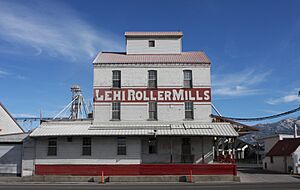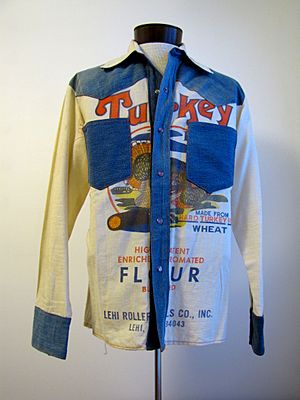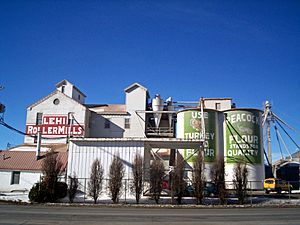Lehi Roller Mills facts for kids
The Lehi Roller Mills is a famous flour mill in Lehi, Utah. It's a historic place that has been grinding wheat into flour for a long time. The first brick building was built in 1905, and it has grown quite a bit since then. This mill is well-known in the Utah Valley because it was a filming spot for the 1984 movie Footloose. The Lehi Roller Mills was added to the National Register of Historic Places in 1994. Today, the building is still standing and operates under the name ‘Lehi Mills’.
Contents
The Story of Lehi Roller Mills
How the Mill Started
After the town of Lehi was settled in 1850, farmers worked hard to grow crops. They used irrigation to bring water to their fields in the dry Utah Valley. Soon, wheat farmers needed a place to turn their wheat into flour. The very first mill in Lehi was started by Samuel Mulliner in 1858. Before this, farmers had to travel far to grind their crops.
Mulliner’s Mill was later sold to other companies. By 1905, there was a big need for a new, modern mill. The Lehi Commercial Club helped organize a plan to build one. They chose a spot on East Main Street because it was close to the Union Pacific Railroad. This made it easy to transport wheat and flour.
The new mill made its first bag of flour in April 1906. It quickly produced sixty to seventy bushels of flour each day. The mill became so popular that it needed to expand within a year. At first, the mill relied on wheat from local farmers. They even advertised to buy wheat and barley from nearby farms.
Growing the Roller Mills Business
In 1910, George G. Robinson took over the mill. He updated the machinery and made the flour even better. By the time World War I began, Lehi Roller Mills was known for its high-quality flour. After Robinson passed away in 1936, his sons, Sherman and Raymond, continued to run the mill.
During World War II, the mill helped the country by selling flour to the government. Over the years, new technology has helped the mill make more and more flour. On the side of the mill, you can still see paintings of the old Turkey Red and Peacock Brand logos. These logos were on the cotton flour bags and showed customers they were getting great flour. People even used the empty flour bags to make things like aprons, tablecloths, and pillowcases!
What Kind of Flour Do They Make?
Lehi Roller Mills gets all its wheat from local farmers. These farms are usually within 100 miles of the mill. Their main types of flour are enriched white flour, called Turkey Flour, and all-purpose flour, called Peacock Flour. They also offer Bread Flour, Baking Flour, and Whole Wheat Flour. The mill uses its flours to make mixes for pancakes, waffles, muffins, and desserts.
The Footloose Movie Connection
The Lehi Roller Mills became famous when it was used as a filming location for the 1984 movie Footloose. The movie was directed by Herbert Ross and starred Kevin Bacon, Lori Singer, John Lithgow, and Sarah Jessica Parker. The story is about a small town where dancing and rock music are banned.
The Roller Mills is a very important place in the film. It's where Kevin Bacon's character works. Kevin Bacon even worked at the mill himself to understand his character better. In a key scene, a group of teenagers hold a secret dance at the Roller Mills to rebel against the ban.
Sherman Robinson, who owned the mill at the time, was approached by a movie producer. The producer saw the mill while driving to Park City and thought it would be perfect for the movie's big dance scene. Robinson agreed to let them film there. Filming brought a lot of excitement to the small town of Lehi. Some local people even got to be in the movie! Students from nearby universities also helped as extra dancers. The film's fame still helps the Roller Mills with sales today.
Lehi Roller Mills Today
Supplying Kentucky Fried Chicken
One of the mill's most famous customers is Kentucky Fried Chicken. In 1952, the Roller Mills provided flour to the very first KFC restaurant in Salt Lake City. This partnership has helped the mill stay in business for many years. Today, the Roller Mills still supplies flour for KFC's chicken coating and cornbread mix in the Western United States.
A National Historic Landmark
The Lehi Roller Mills was recognized as a National Historic Place in 1995. The building has kept many of its original features since it opened. It also shows how milling technology has changed since 1910. You can still see the original grain elevators with the Turkey Red and Peacock Flour logos. The three-story brick building is also original. Inside, some of the old machines and signs are still there. The mill still uses electric milling technology to grind flour. It is one of the few historic mills of its kind still standing in Utah.
The Mill's Recent Journey
Lehi has grown a lot in recent years, with more homes and technology. This means less land is used for farming. Because of this, and some financial problems, the Roller Mills faced challenges around 2013.
During a tough time, Ken Brailsford bought the Mills in 2013 from the original founder's grandson. Before this, the mill already sold baking mixes. But since the change in ownership, the company has focused on selling more to everyday customers. These prepackaged mixes are now available all year in the mill's new store and online. Sales have grown across the country. A new warehouse was built in American Fork to store products for the growing demand. The grandson of the original owner, Sherm Robinson, still helps run the mill today.





